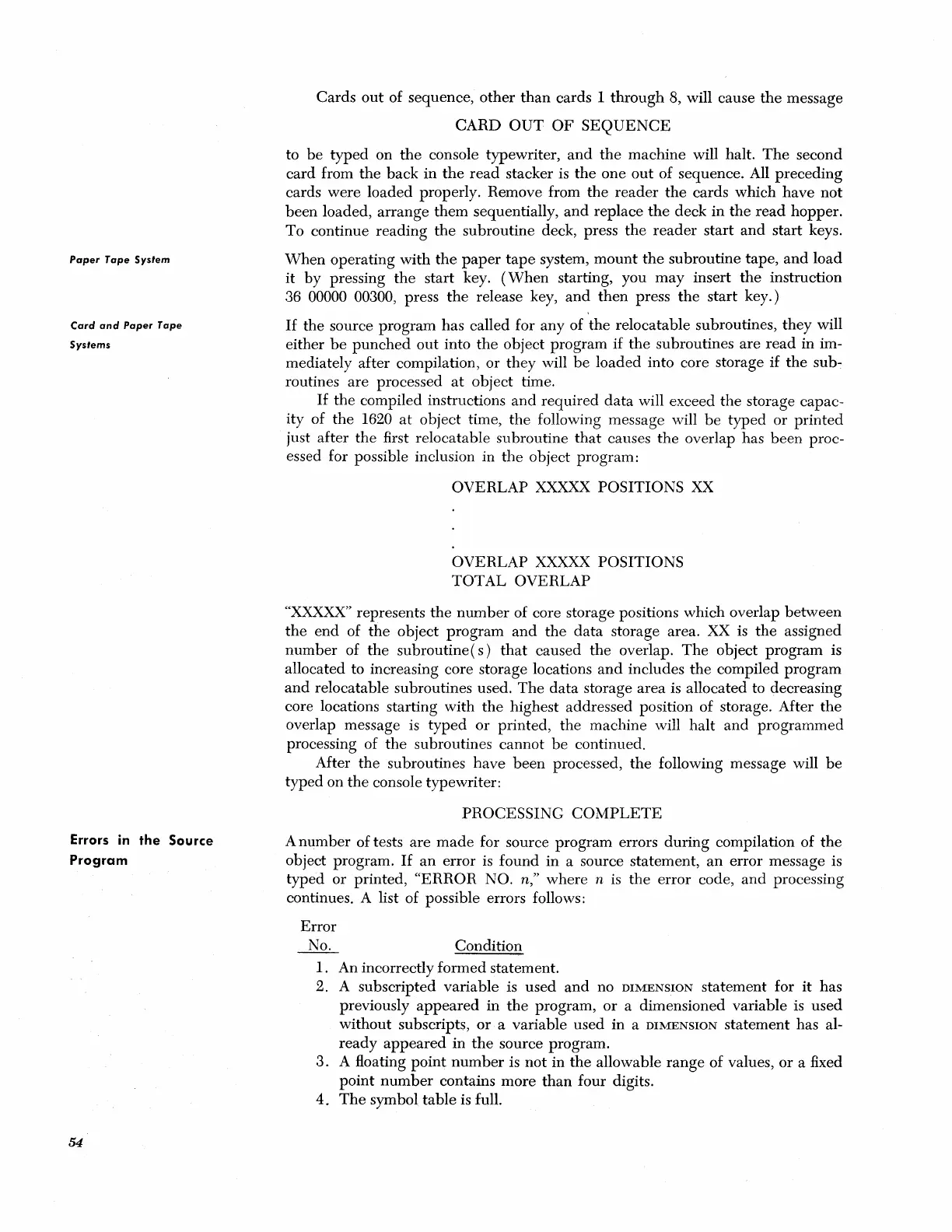Paper
Tape
System
Card
and
Paper
Tape
Systems
Errors in the Source
Program
54
Cards
out
of sequence,
other
than
cards 1
through
8, will cause
the
message
CARD
OUT
OF
SEQUENCE
to
be
typed
on
the
console typewriter,
and
the
machine
will halt.
The
second
card
from
the
back
in
the
read
stacker is
the
one
out
of sequence. All
preceding
cards
were
loaded
properly. Remove from
the
reader
the
cards which
have
not
been
loaded,
arrange
them
sequentially,
and
replace
the
deck
in
the
read
hopper.
To
continue
reading
the
subroutine deck, press
the
reader
start
and
start keys.
When
operating
with
the
paper
tape
system,
mount
the
subroutine tape,
and
load
it by pressing
the
start key.
(When
starting, you
may
insert
the
instruction
36
00000 00300, press
the
release key,
and
then
press
the
start
key.)
If
the
source program has called for any of
the
relocatable subroutines,
they
will
either
be
punched
out
into
the
object program
if
the
subroutines
are
read
in im-
mediately after compilation, or
they
will
be
loaded
into core storage
if
the
sub-
routines
are
processed
at
object time.
If
the
compiled instructions
and
required
data
will exceed
the
storage capac-
ity of
the
1620
at
object time,
the
following message will
be
typed
or
printed
just after
the
first relocatable subroutine
that
causes
the
overlap has
been
proc-
essed for possible inclusion in
the
object program:
OVERLAP
XXXXX
POSITIONS
XX
OVERLAP
XXXXX POSITIONS
TOTAL
OVERLAP
"XXXXX"
represents
the
number
of core storage positions which overlap
between
the
end
of
the
object
program
and
the
data
storage area.
XX
is
the
assigned
number
of
the
subroutine (
s)
that
caused
the
overlap.
The
object
program
is
allocated to increasing core storage locations
and
includes
the
compiled
program
and
relocatable subroutines used.
The
data
storage area is allocated to decreasing
core locations starting with
the
highest addressed position of storage. After
the
overlap message
is
typed
or
printed,
the
machine will
halt
and
programmed
processing of
the
subroutines cannot
be
continued.
After
the
subroutines
have
been
processed,
the
following message will
be
typed
on
the
console typewriter:
PROCESSING
COMPLETE
A
number
of tests
are
made
for source program errors
during
compilation of
the
object program.
If
an
error is
found
in
a source statement,
an
error message is
typed
or
printed,
"ERROR
NO.
n,"
where n is
the
error code,
and
processing
continues. A list of possible errors follows:
Error
~
Condition
1. An incorrectly formed statement.
2. A subscripted variable is
used
and
no
DIMENSION
statement for
it
has
previously
appeared
in
the
program,
or
a dimensioned variable is
used
without subscripts,
or
a variable used
in
a
DIMENSION
statement has al-
ready
appeared
in
the
source program.
3.
A floating
point
number
is
not
in
the
allowable
range
of values,
or
a fixed
point
number
contains
more
than
four digits.
4.
The
symbol
table
is full.
